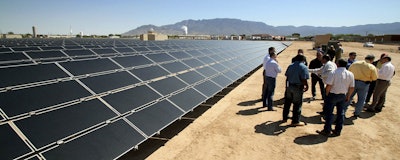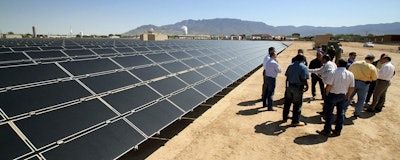
 This April 20, 2011 file photo shows officials with Arizona-based First Solar and Public Service Co. of New Mexico gathering after the dedication of the utility's new 2-megawatt photovoltaic solar array in Albuquerque, N.M. New Mexico lawmakers are considering legislation during the 2019 session that sets aggressive new quotas for renewable energy production and attempts to address some of the economic costs of closing a coal-fired power plant near Farmington, N.M. (AP Photo/Susan Montoya Bryan)
This April 20, 2011 file photo shows officials with Arizona-based First Solar and Public Service Co. of New Mexico gathering after the dedication of the utility's new 2-megawatt photovoltaic solar array in Albuquerque, N.M. New Mexico lawmakers are considering legislation during the 2019 session that sets aggressive new quotas for renewable energy production and attempts to address some of the economic costs of closing a coal-fired power plant near Farmington, N.M. (AP Photo/Susan Montoya Bryan)New Mexico is known for its wide-open spaces, wind-swept plains and nearly endless supply of sunshine, and yet the promise of an economy built on renewable energy has been elusive for the state's politicians for years.
That could change under a measure that won bipartisan approval in the state Senate late Wednesday. With the House being the last stop before reaching the governor's desk, the race is on for New Mexico lawmakers to follow the lead of California and Hawaii in the push toward carbon-free electricity generation over the next 25 years.
The landmark legislation under consideration in New Mexico sets aggressive new quotas for renewable energy production, going so far as to require publicly regulated utilities to produce all of their electricity from carbon-free sources by 2045.
Electric co-ops that provide power to more rural areas of the expansive and sparsely populated state would have another five years to meet that goal.
The wheels already are in motion as New Mexico's largest electric provider — Public Service Co. of New Mexico — plans to divest itself from coal-fired generation within a few years.
While the legislation seeks to address some of the economic consequences of shuttering the San Juan Generating Station, New Mexico still would need to see a fivefold increase in the amount of electricity produced by solar panels, wind farms and other carbon-free sources to reach the proposed goals. The current mandate calls for 20 percent of power to come from renewable sources.
Jeff Deyette, director of state policy and analysis for the Union of Concerned Scientists' climate and energy program, said it will be less of a daunting task than the one faced by political leaders years ago, when technology had yet to tip the renewable energy scales in favor of accessibility and affordability.
"The time frame by which we're taking about — over the next 20 to 25 years — it's just eons in terms of the capacity and ability of continued innovation in technology," he said.
New Mexico was declared the "Clean Energy State" more than a decade ago by then-Gov. Bill Richardson. His administration oversaw implementation of the state's initial renewable energy portfolio standard and he had aspirations of developing transmission networks to export New Mexico's renewable resources to larger markets and of attracting solar panel manufacturers and other green jobs to the state.
There have been stumbling blocks along the way, but more large-scale wind farms have been built and solar capacity is growing, in part due to solar generating stations brought online to feed Facebook's new data center.
Richardson, who also served as U.S. energy secretary in the Clinton administration, said in an interview that he still believes the future of the state hinges on renewable energy.
"Yes, it's a challenge but I think this is a step in the right direction," he said of the legislation.
Supporters say the shift by Public Service Co. of New Mexico also is opening the door for more renewable energy. Just a few years ago, coal generation made up about 60 percent of the utility's portfolio. That's down to about 30 percent, with a mix of natural gas, solar, wind and nuclear making up the rest.
Utility officials say they're already on track to generate more than 25 percent of electricity from renewable sources by the end of the year. While the mandates helped early on, they say cost competitiveness is now driving utilities to invest in more renewable and carbon-free energy.
The Democratic-led New Mexico House of Representatives is under pressure from environmental groups, the utility and Gov. Michelle Lujan Grisham to approve the measure before the session ends in about a week.
Lujan Grisham has been cheering on the legislation through social media posts, as building up the state's clean energy capacity was among her campaign promises.
Governors in Wisconsin and Colorado also have campaigned on renewable energy. In Washington state, Gov. Jay Inslee has been pushing legislation aimed at eliminating fossil fuels like natural gas and coal from his state's electricity supply by 2045.
In Massachusetts, lawmakers are proposing a $1 billion, decade-long plan for cities and towns to adopt new technology designed to curb greenhouse gas emissions. It includes money for renewable energy and energy efficiency programs.
Similar legislation pushing for raising the renewable energy quotas also is pending in Illinois and Minnesota.
"Years ago, California first lead the way with 50 percent," Deyette said. "Now we've just sort of leaped ahead."






















